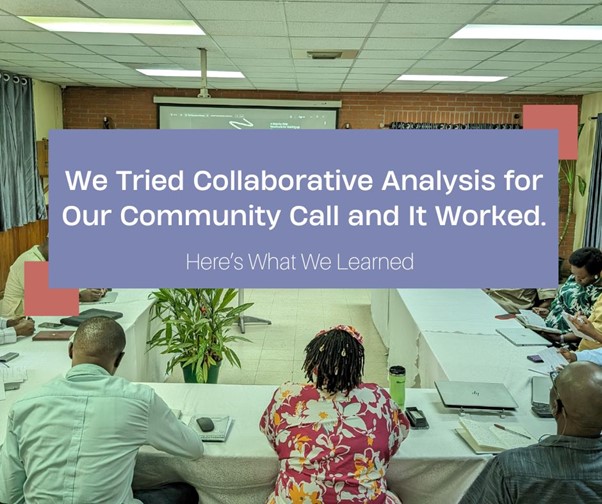By Akinyemi Muhammed
The nature of our community calls at NAMIP is to help participants learn from the successes and failures of other participants across different areas of specialization, and to exchange notes where necessary. Sometimes, the teaching comes from coaches outside the program who are familiar with our objectives. However, NAMIP decided to take a slightly different approach to our community call on April 16, 2022, through collaborative analysis.
Collaborative analysis is when a group of people come together to study something, like an article or a report. Instead of one person teaching everyone else, everyone shares their thoughts and ideas. Together, they talk about what they’ve read, ask questions, and try to understand it better. It’s like a team effort to figure things out, where everyone’s input is important.
This month’s collaborative analysis themed community call analysed FT Strategies and Knight Lab’s ‘NEXT GEN NEWS: Understanding the audiences of 2030’ report.

The report was divided into three major segments, which we also clustered participants around to share how they were using the segment’s recommendations in their newsrooms. Here is how NAMIP participants responded:
Audience trends
- Following the report’s recommendations for newsrooms to actively study their audiences, understand their interests and how to serve them, some newsrooms shared how they were using analytics tools to understand audience interests more intently. For one newsroom, their understanding of audience trends has helped them understand some of their existing products were not serving their current audience, leading to them sunsetting the said products.
- For other newsrooms, the report’s recommendations have been helpful with planning future products and ensuring they speak to their core audiences before creating products from a bubble.
- Interestingly, some newsrooms agreed with what their colleagues shared and promised to implement both the report’s recommendations and what their colleagues from other newsrooms had done.
The ideal news experience
- During the interesting segment on how to present news to the future audience, a newsroom from this cluster explained the importance of creating news using platform familiar language, especially in distribution. While video content used to evoke similar responses in the past, how videos are produced, captioned, and distribution need to vary across different platforms like TikTok, Instagram, and YouTube to benefit from the nuances of each platform’s user experience.
- Other newsrooms explained how some of their products were struggling with conversion but will start utilizing recommendations from both the report and other colleagues to ensure they are being platform-conscious when distributing news and other materials to their audiences.
Meeting consumer needs
- In what is perhaps the most vital part of the report, newsrooms within this cluster shared overall recommendations on how to produce news for future audiences. This, in some instances, include building trust at the risk of breaking news, as a newsroom leader shared. The newsroom leader explained how rushing to break stories without a full picture slowly break trust with the audiences who are leaning towards consuming only stories from platforms they trust, in the wake of weaponized misinformation and disinformation on the internet.
- Another newsroom explained to the rest of the cohort that part of their method towards preparing news for the future audience is sitting with the said audience occasionally and jointly analysing what their interests and priorities were. They explained that this helped them to create ultra specific resources and news to their audiences with varying backgrounds without leaving anyone’s interests on the table.
- A resounding sentiment shared among publishers, newsroom managers, reporters, and editors during the community call was the need for newsrooms to do more focused work in understanding their unique audiences and ensuring that the audiences were catered to based on their interests.
What we learned
While there were several lessons during the community call, including Editors-in-Chief sharing how they were using the report to enhance operations in their newsrooms and their understanding of their audiences, a crucial element for NAMIP was the role of critical analysis and collaborative learning during the call.
- Critical analysis means really looking at information and deciding if it’s reliable or not, which is crucial in today’s world full of fake news. Participants were able to analyse the report by its merits, sharing the things they believed was useful to their editorial context and explaining why some of the report’s findings may be more difficult to execute than other.
- Collaborative learning is about working together with different people to understand things better. When journalists do this, they not only get better at thinking critically but also learn from each other’s perspectives. This helps them become more open-minded and ready to tackle the tough issues they face.
Seeing the participants exude strong critical analysis and collaborative learning was a win on NAMIP’s part, as one of our core objectives is to continue to reinforce collaboration in Nigeria’s media ecosystem.
In an hour and thirty minutes, we saw — through collaborative sharing and analysis — how the report applied to newsrooms across broadcast, print, and online publications, and how several newsrooms were looking to apply the report’s findings to their respective contexts.
As NAMIP continues to provide opportunities for knowledge exchange in Nigeria’s media space and beyond, we believe it is important to emphasize that collaborative analysis offers significant benefits in journalism education (and re-education). By working together, journalists are exposed to diverse perspectives, and deepen their understanding of complex topics. This approach fosters critical thinking skills and encourages active participation, enhancing the overall learning experience. Moreover, the collaborative nature of the process promotes a sense of community and camaraderie among colleagues.

